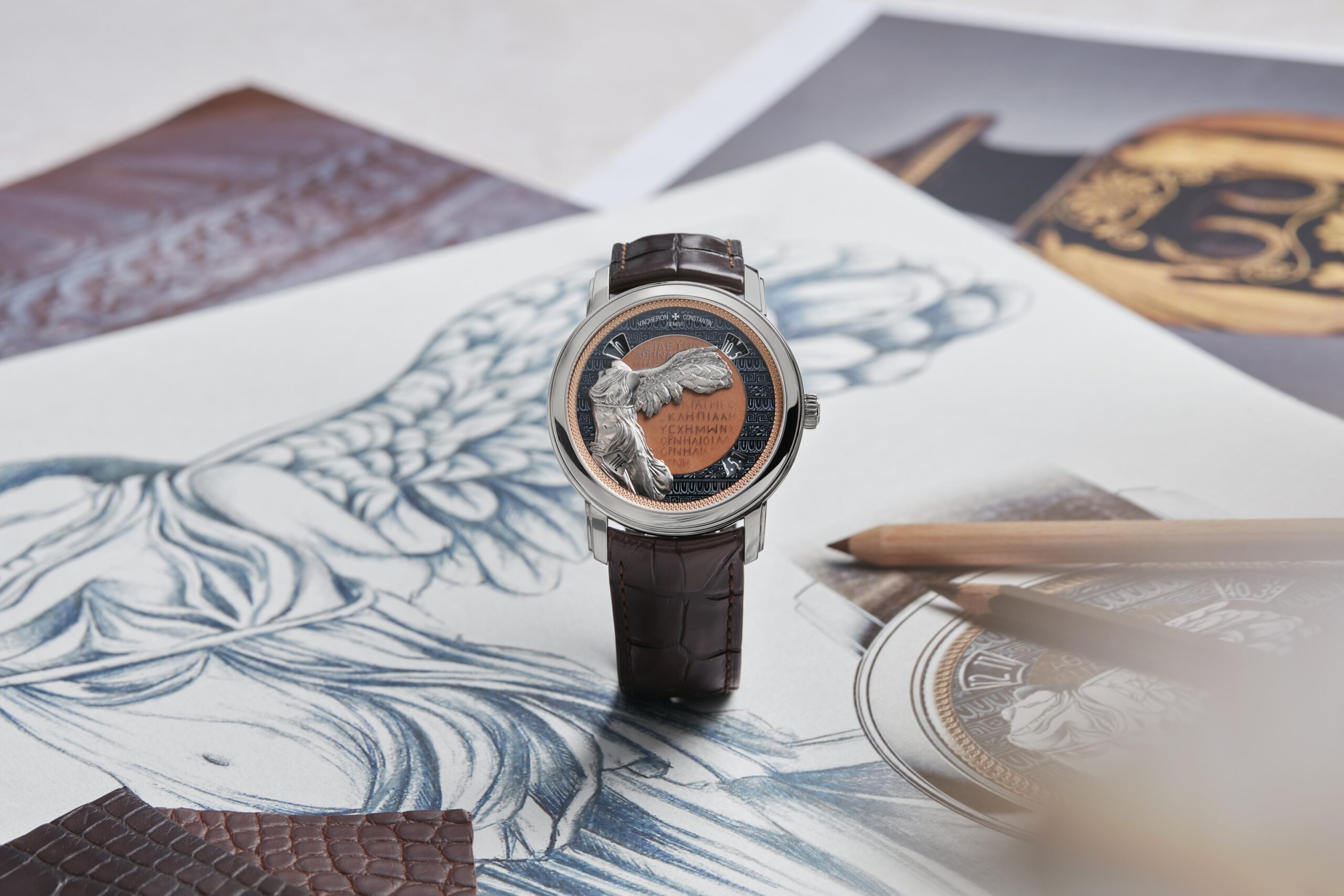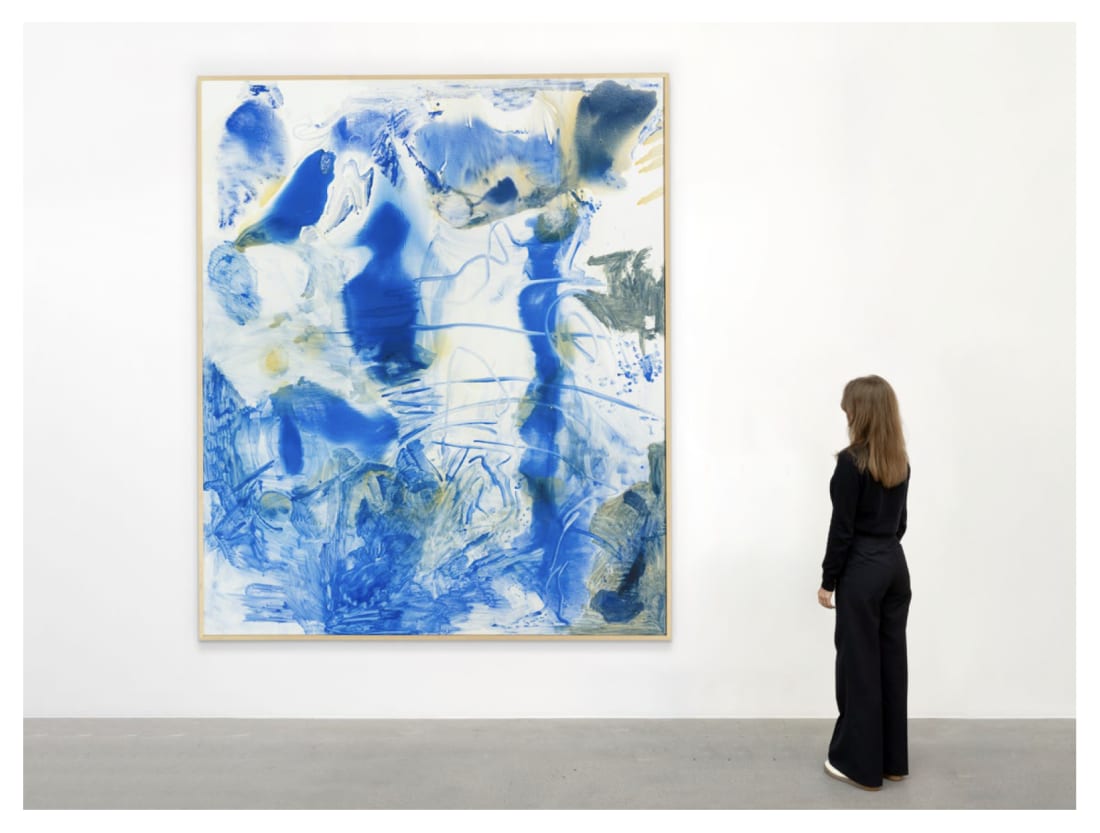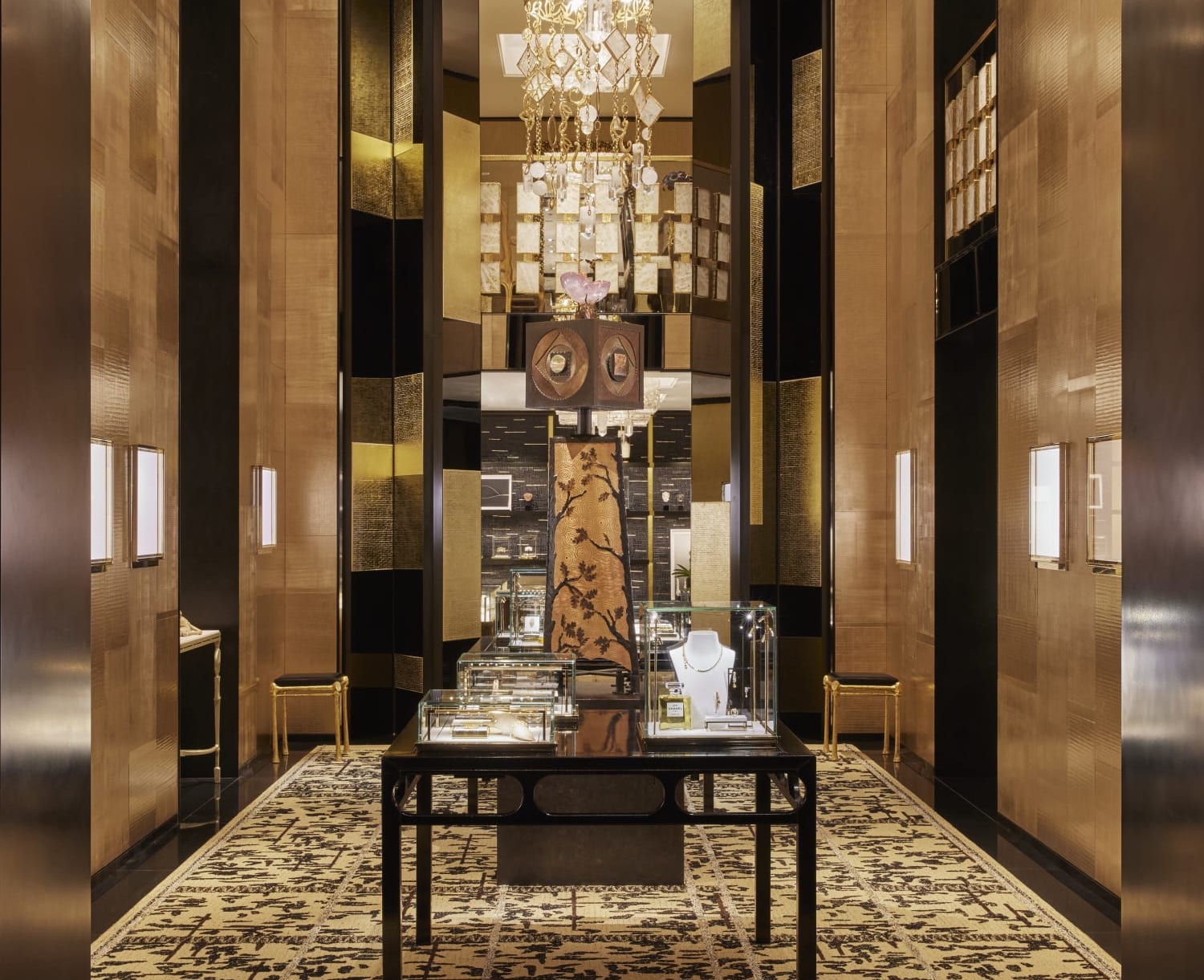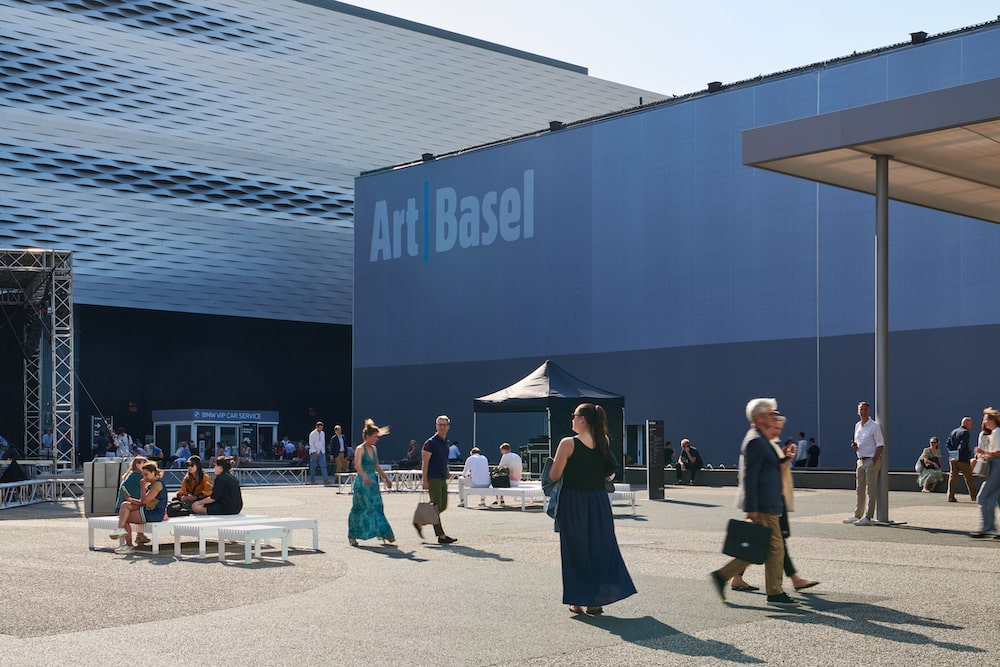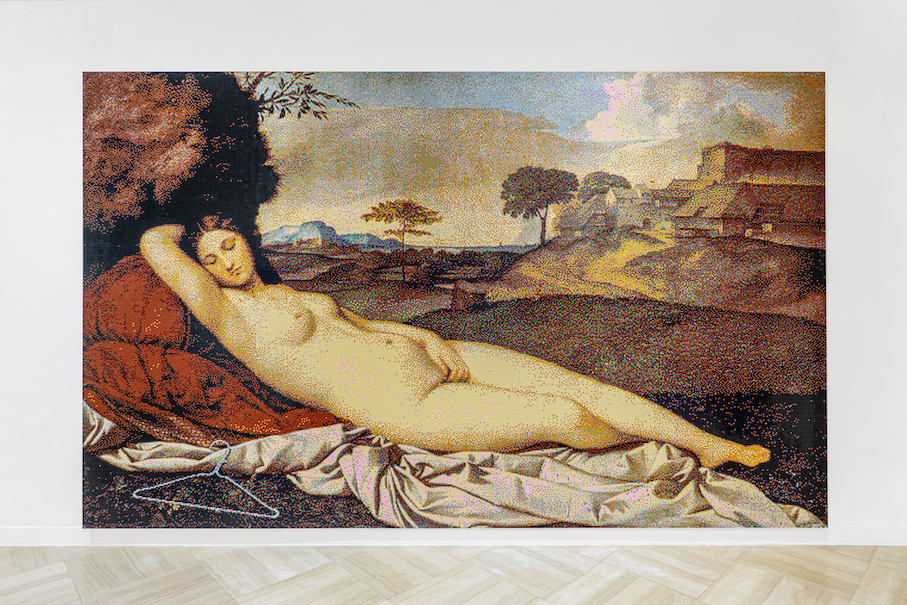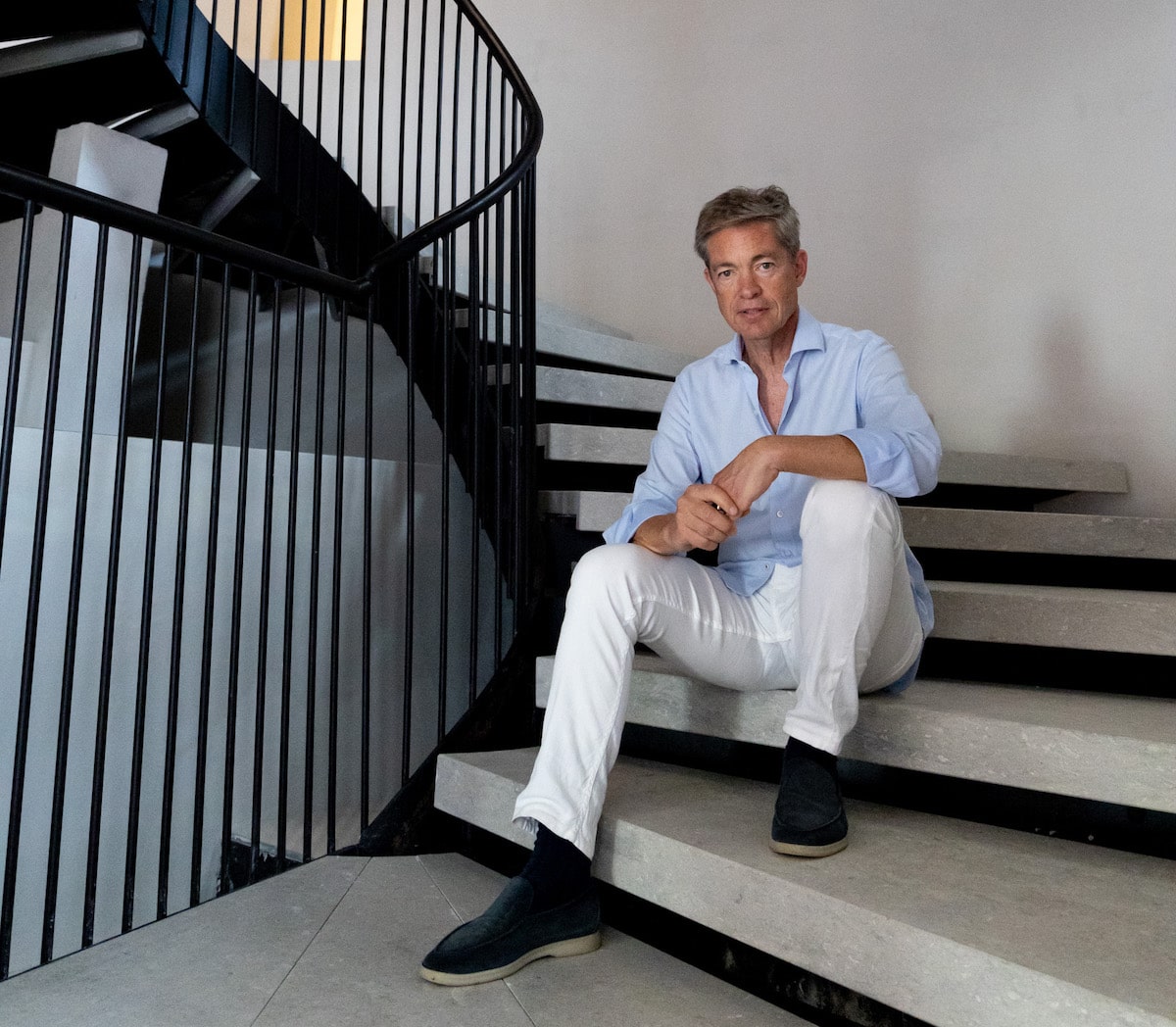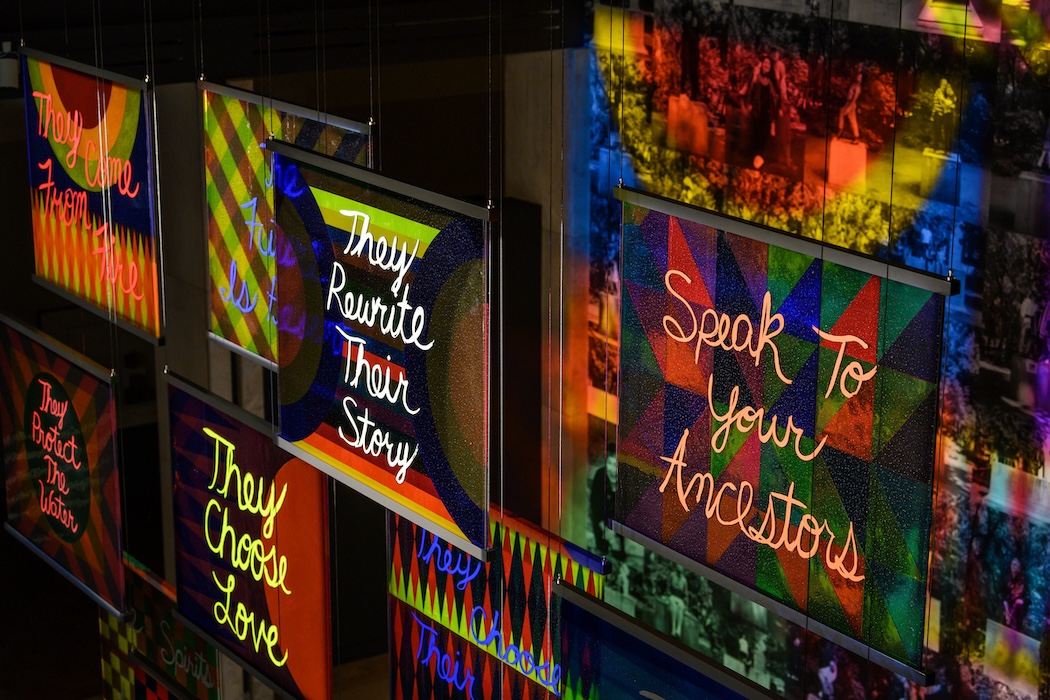As you approach the British Pavilion at the Venice Biennale, you are immediately enveloped by the atmospheric brilliance of Sir John Akomfrah‘s monumental installation, “Listening All Night to the Rain.” This masterful exhibition, composed of eight intricately interconnected Cantos, guides visitors through a mesmerizing journey where visual and sonic narratives intertwine seamlessly. Inspired by the poetic methods of Su Dongpo and the historical introspections of Ezra Pound, Akomfrah creates a landscape of song-like movements that invite contemplation and active listening as forms of aesthetic and political engagement.
 Photo by Christian Cassiel. © John Akomfrah © Lisson Gallery.
Photo by Christian Cassiel. © John Akomfrah © Lisson Gallery.
Akomfrah Offers Critical and Poetic Connections
The exhibition‘s title, drawn from an 11th-century poem by Su Dongpo, sets a contemplative and evocative tone, guiding viewers through an exploration of life’s fleeting nature and the profound act of listening. Central motifs such as bodies of water, clocks, and metronomes serve as symbolic threads that weave the multifaceted narratives together, creating a cohesive yet richly layered experience. Canto I, displayed on the facade of the British Pavilion, establishes the thematic and visual motifs that permeate the entire installation. Akomfrah’s innovative use of visual and sonic elements is evident in his choice of filming locations, which span from the haunting beauty of Scotland’s boat wrecks to the socio-economic remnants of Yorkshire.
These landscapes not only provide a poignant backdrop but also evoke the historical and cultural contexts that underpin his work. By juxtaposing newly filmed material with archival footage, Akomfrah creates a dynamic dialogue between past and present. This approach, known as bricolage, involves the assemblage of diverse materials—found images, audio clips, and texts from international archives—to construct new meanings and challenge conventional narratives. Through this intricate interplay of visual and auditory elements, Akomfrah repositions the role of art in writing history, offering critical and poetic connections between different time periods and geographies.
 John Akomfrah, “Arcadia” (still), 2023. © Smoking Dogs Films © Lisson Gallery.
John Akomfrah, “Arcadia” (still), 2023. © Smoking Dogs Films © Lisson Gallery.
An Artistic Journey From the Black Audio Film Collective to a Solo Career
Sir John Akomfrah’s artistic journey from the Black Audio Film Collective to his distinguished solo career is a testament to his unwavering commitment to addressing complex socio-political issues. Born in Accra, Ghana, in 1957, Akomfrah fled to England with his family following a violent coup that claimed his father’s life. These life events deeply influenced his artistic vision, driving him to explore themes of memory, colonial history, and migration. His early work with the Black Audio Film Collective, notably “Handsworth Songs”, showcased his innovative use of archival footage and multi-screen installations, which have since become hallmarks of his narrative style. Throughout his illustrious career, Akomfrah has consistently engaged with themes of post-colonialism, ecology, and the politics of aesthetics. His latest work, “Listening All Night to the Rain”, delves into acoustemology, examining how sonic experiences shape, connect, and reflect cultural realities.
In an exclusive interview with Whitewall, Sir John Akomfrah delves into his work for the Venice Biennale and his broader artistic practice. He reflects on his journey from co-founding the Black Audio Film Collective to his current solo projects. Akomfrah offers insights into his innovative vision, ground-breaking work, and commitment to social justice.
 BAFC & John Akomfrah, “Handsworth Songs” (still), 1986. © Smoking Dogs Films and Lisson Gallery.
BAFC & John Akomfrah, “Handsworth Songs” (still), 1986. © Smoking Dogs Films and Lisson Gallery.
WHITEWALL: What inspired you to title your Venice Biennale installation “Listening All Night to The Rain”? Is there a particular significance or story behind it?
SIR JOHN AKOMFRAH: Yes, there is. Usually, the titles for my pieces come much later—I don’t have the idea for a title until much later in the process. However, this time the title came first, even before the main piece. I’ve been fascinated by the idea of incorporating elements of poetry for a long time, but I don’t like to use poetry as mere quotations for the pieces themselves. I’ve been intrigued by the methodologies of poetry writing for a while.
I came across an 11th-century poem called “Listening All Night to The Rain” by the Chinese poet Su Dongpo. I was struck by its method. It felt very modern, almost like a stream-of-consciousness style. He would mention one thing in two lines and then move to something completely different in the next two lines, and so on. You had a poem of, let’s say, ten lines, five stanzas, each with different imagery. They were all connected by mood and tone rather than by subject matter or location. This seemed to me a really good method, a really good approach for a pavilion with seven spaces. I wanted to find a way to create something connected or interconnected, but not the same. So the title came first.
An Immersive Pavilion of Self-Contained Islands Unfolds in Venice
WW: “Listening All Night to the Rain ” is divided into eight Cantos, each exploring different themes. How did you decide on these specific themes, and how do they interconnect?
SJA: They all share a set of obsessions and preoccupations, and a series of interconnected motifs. When you first encounter the work, Canto I is outside. What strikes you there are texts in images that are either floating or submerged in water, establishing water as a recurring motif throughout the pieces. The second theme revolves around the art of listening itself. Many of these Cantos share an overlapping obsession with people listening, recollecting, or being entranced by sound, by audibility itself, creating a cohesive thread through the work.
Ultimately, I wanted to create a pavilion with self-contained islands. You can sit in one and think, “Okay, this is all about growing up in England in the 1960s and 70s.” Then you might wander into another room and realize, “Oh, this is about the impact of pesticides in the 50s and 60s and how this connects to the Vietnam War.” Each Canto serves as a unique exploration of themes such as memory, migration, environmental impact, and socio-political histories, yet they are all interconnected through motifs like water and listening.
The idea was to provide an exhibition where people could immerse themselves in one Canto, deeply exploring its specific theme. But if they choose to move around due to limited time, there should be connective tissue—recurring motifs and themes—that allows them to trace their journey and see the interconnectedness of these varied narratives. This way, each Canto stands alone in its narrative while also contributing to a larger, cohesive whole, encouraging reflection on the interplay between different historical and contemporary issues.
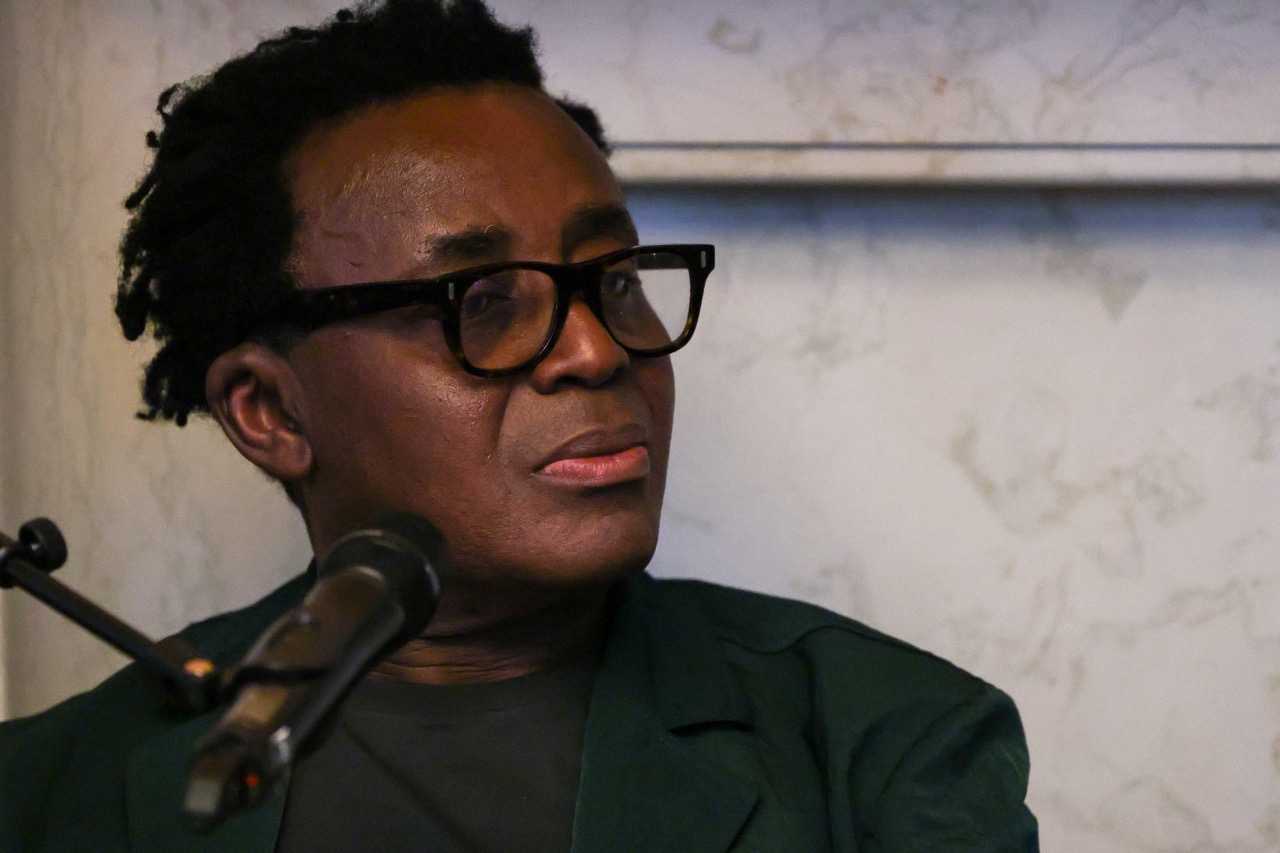 VENICE, ITALY – APRIL 18: John Akomfrah speaks during a talk by Talk Art and John Akomfrah, supported by Burberry, during the opening week of the 60th International Art Exhibition, La Biennale di Venezia, on April 18, 2024 in Venice, Italy. (Photo by Dave Benett/Getty Images for Burberry)
VENICE, ITALY – APRIL 18: John Akomfrah speaks during a talk by Talk Art and John Akomfrah, supported by Burberry, during the opening week of the 60th International Art Exhibition, La Biennale di Venezia, on April 18, 2024 in Venice, Italy. (Photo by Dave Benett/Getty Images for Burberry)
Democratizing the Palette of Experience in Symbolic Artworks
WW: Recurring motifs like clocks, bicycles, oranges, and rubber ducks appear throughout the installation. Can you please elaborate on their symbolism and how they contribute to the overall narrative?
SJA: Sometimes, the symbolism is very, very simple. If I may say so, it’s not always profound in its inspiration. For instance, the rubber ducks. I remember watching a news item about a tanker that sank with goods from China. When it sank, one of the things that went down was a container filled with plastic ducks. The container burst open, releasing these plastic ducks into the ocean. Ever since then, over the past 25 years, they’ve been found all over the world. So, the presence of these plastic ducks in the pieces is due to that one storm. It felt like an interesting way to illustrate climate change and the interconnectedness of our global scene. It’s important to realize that when you take a stand on plastic waste in West Africa, it has implications for Antarctica.
As for the clocks motif you mentioned, clocks have been a feature of my work for a while, and I’ve added metronomes to that. I’m fascinated by using objects not as symbols or metaphors, but for what they really are. They’re not standing in for something else. Both metronomes and clocks are indexical machines—they measure time. They gauge and mirror time. I’m keen on people viewing my work and instantly understanding ideas, narratives, and stories without needing an explanation. They might have to think about the implications, but they get it right away.
I’m interested in making popular, everyday objects circulate within the pieces in a way that creates immediate access to the work, even if people say they don’t fully understand it. There’s an attempt to democratize the experience, so you feel an immediate connection to those works. Even if you say, “I don’t really understand”, you at least understand what a clock does. I’m trying to democratize the palette of experience that the works offer.
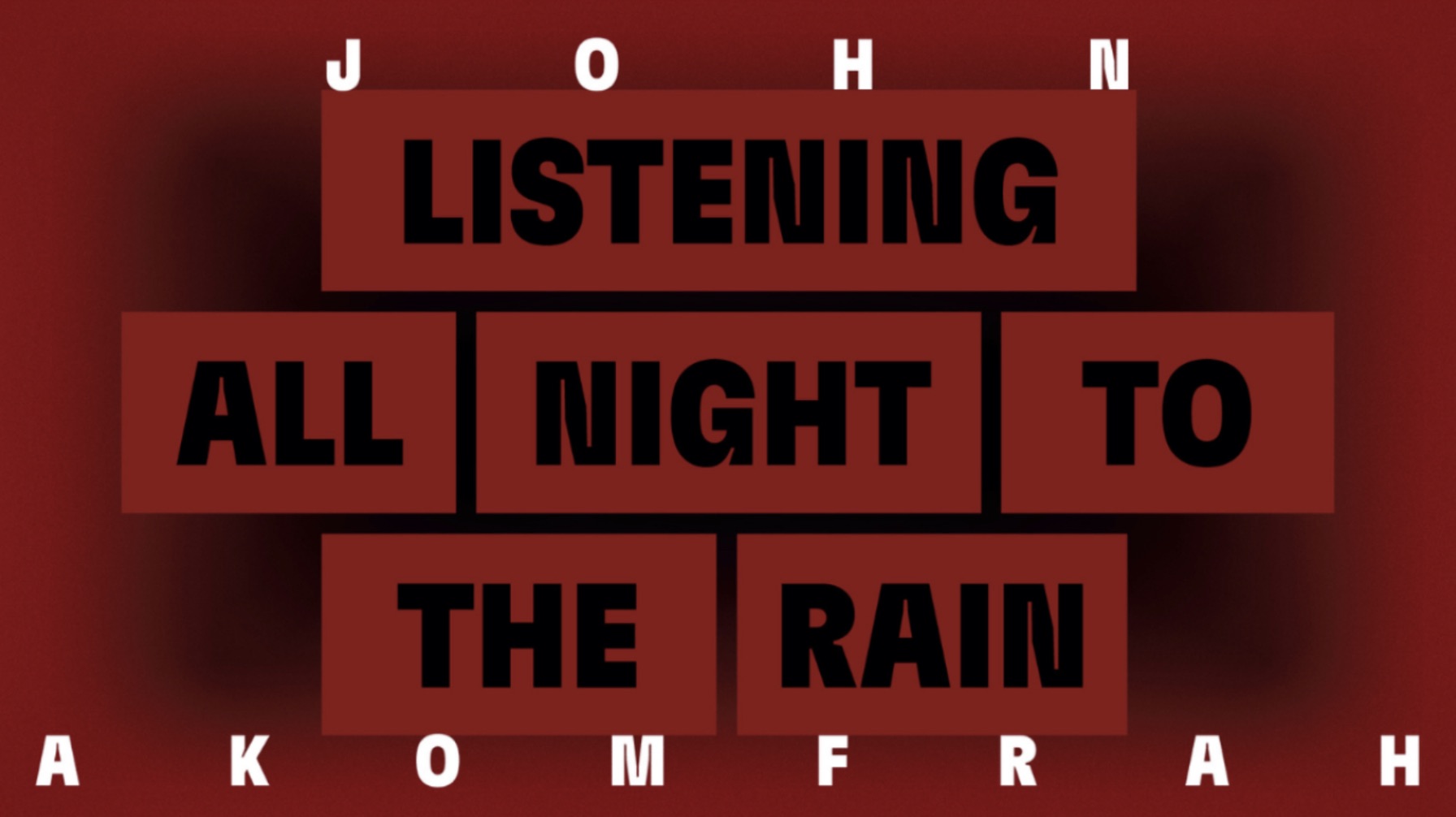 John Akomfrah, “Listening All Night to the Rain” (2024). © John Akomfrah © British Pavilion 2024.
John Akomfrah, “Listening All Night to the Rain” (2024). © John Akomfrah © British Pavilion 2024.
“I’m keen on people viewing my work and instantly understanding ideas, narratives, and stories without needing an explanation,”
Sir John Akomfrah
Reflecting on the Struggles of Migrant Communities
WW: Memory and migration are recurring themes in your work. How do these themes resonate with your personal experiences and influence your creative process?
SJA: It’s interesting that you ask this question. At any other time, it might have felt abstract or purely intellectual, but given the recent events, which can only be described as racist riots, it’s incredibly pertinent. When you listen to many of those involved, they often say, “enough is enough.” Their sentiments are deeply rooted in this country’s colonial and imperial past.
My engagement with these themes is not merely personal; it’s a shared preoccupation. Many writers I admire have spoken about the melancholia or the lingering colonial, imperial hangover that persists here. It’s almost as though we need to work through the implications of past events, and many are struggling to adapt, to realize that changes are not as problematic as they think. For example, someone in Dagenham might believe that not having a job is because of people like me being here, but that’s not the case.
As a child of migrants, these subjects are deeply personal to me. My work aims to reflect these experiences and the broader struggles of migrant communities. For example, Nigel Farage’s comments on two-tier policing and stop-and-search policies remind me of my own experiences in the 1970s when I was frequently targeted. The issue for migrant communities isn’t policing itself but the indiscriminate racial profiling that often accompanies it. People seek fair policing practices, not ones that profile them based on race.
The intersection of my work and the societal context in which it exists is often very porous. While I may not create pieces specifically about policing, the questions of who gets to enjoy freedoms and who doesn’t are always present in my mind. These ongoing conversations about policing and broader social issues naturally influence my creative process, shaping the narratives and themes I explore in my work.
“These ongoing conversations about policing and broader social issues naturally influence my creative process, shaping the narratives and themes I explore in my work,”
Sir John Akomfrah
Utilizing Crucial Archival Materials
WW: Your use of archival footage is a signature element of your installations. What is your process for selecting and integrating these historical materials into your films?
SJA: Good question. The selection and integration of archival footage are fundamental to my work and are deeply tied to the identity and structure of each piece. This process varies with each project, but the use of archival imagery remains a constant. Archival footage serves to structure the tone and narrative for two main reasons. First, many subjects I tackle have an ambiguous relationship with the present—they appear contemporary but are deeply connected to the past. This duality helps navigate the present and acts as a gateway to both past and future contexts.
Archival material is crucial because it lends a sense of identity to my projects. I am drawn to subjects infused with memory and history, as they provide a sense of reality and humanity, making the narratives more relatable and emotionally resonant. While I may not fully grasp all the intellectual reasons behind this, I know why it resonates with me emotionally. Each project, upon completion, makes me reflect on how much of myself is still present within it. I gauge this by examining the interplay between archival and non-archival elements. This is why archival footage features so prominently and consistently in my work—it helps create a layered, multidimensional narrative that bridges different time periods and experiences.
 Still from “Listening All Night To The Rain” by John Akomfrah, commissioned by the British Council, courtesy of Lisson gallery and Smoking Dogs Films.
Still from “Listening All Night To The Rain” by John Akomfrah, commissioned by the British Council, courtesy of Lisson gallery and Smoking Dogs Films.
“I am drawn to subjects infused with memory and history, as they provide a sense of reality and humanity, making the narratives more relatable and emotionally resonant,”
Sir John Akomfrah
Art as Forensic Investigation of the Environment
WW: Climate change is a prominent theme in your recent works, such as “Purple.” How do you see the role of art in addressing environmental issues and influencing public discourse?
SJA: Art has always addressed environmental issues. These are universals that interest me. If you look at significant works from the 19th century – take Turner or Monet, for example—you are immediately struck by their obsessions. These fascinations, which I call the great universals, include light, the elements, and so on. The preoccupations of art often overlap with the subjects of climate change. Environmental change affects how light behaves, the culture, and the sense of what you see when you look at the landscape. All these aspects – like what water feels and looks like—are almost like reports from the past to us. They are great artworks but also forensic investigations of the environment.
I don’t feel that I am doing something radically different from artists like Kandinsky. However, it feels irresponsible not to recognize the interconnectedness of all things, including the relationship between artistic expression and the world we inhabit. I am not an environmental activist in the traditional sense; like someone who might create a piece like “Guernica” to directly address a specific crisis. My intention is not to create works that speak solely about environmental collapse, but rather to comment on the present moment.
Fifty years ago, it might have been possible to overlook these questions, but today, an honest and clear discourse about the present must include environmental considerations. For instance, if you are a landscape painter now, it would be impossible to ignore the stark transformations in our natural surroundings. I recently saw two photographs taken 15 years apart in the French Alps. In the first, a couple stood beside glaciers and fantastic ice formations. Fifteen years later, they took another photo in the same location, but now there was nothing but a lake. These images starkly reveal the dramatic changes occurring in our world. Even if you are not consciously focusing on environmental issues, it is impossible to ignore them when you observe such transformations.
 Still from “Listening All Night To The Rain” by John Akomfrah, commissioned by the British Council, courtesy of Lisson gallery and Smoking Dogs Films.
Still from “Listening All Night To The Rain” by John Akomfrah, commissioned by the British Council, courtesy of Lisson gallery and Smoking Dogs Films.
“Art has always addressed environmental issues,”
Sir John AkomfrahMeditating on a Sense of Ownership and Freedom
WW: Reflecting on your journey from the Black Audio Film Collective to your solo works, how do you feel your artistic vision and style have changed over the years?
SJA: That’s a difficult question. I am conscious of the fact that certain preoccupations—such as memory, the colonial past, and multiculturalism—have consistently emerged in my work. However, I’m not consciously trying to continue or disavow these themes. When I plan a project, it’s not a deliberate effort to revisit these ideas, although it might sometimes appear that way.
What has changed, and what I believe should change for anyone at my stage in life, is the sense of ownership, control, and freedom that comes with experience. This is my third or fourth journey through the labyrinth, so to speak, and I now understand the terrain better. I’ve left markers and resources to draw upon. Undoubtedly, things are much easier compared to forty years ago. But I don’t think this is unique to me; it’s a common experience. If you’ve been immersed in something long enough, it starts to make sense, or at least, some glimmers of understanding appear. That’s where I am now, and I’m very happy about that.

